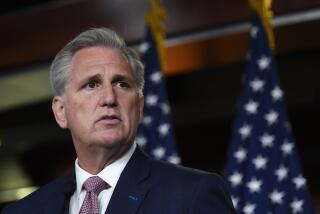An Economic Plan That Cancels Itself
- Share via
President Bush’s proposed budget blurs the important distinctions between stimulus and growth. Given the differing objectives of the two -- on the one hand increasing spending to stimulate the economy in the short term and on the other increasing saving to boost longer-term growth -- it is nearly impossible to accomplish both.
With the stimulus and growth components of the president’s economic proposals canceling each other out, the budget plan is likely to accomplish neither.
When stimulus is the objective, deficit spending makes sense as a way to funnel more money through the economy to speed up recovery. An effective stimulus policy should be both targeted, to ensure that the funds are spent rather than saved, and temporary, to avoid an ongoing drain on the budget.
The purpose of a long-term growth package is the opposite. Changes in the tax code can minimize distortions that slow economic growth. One way is to encourage rather than punish saving and investment, which are the ultimate engines of growth.
So how does the Bush budget plan stack up?
Not well. His $360-billion plan to eliminate dividend taxes and vastly increase the individual saving that can be accumulated tax-free is structured primarily as a growth package -- yet deficit-financed as though it were a stimulus. The result: Poorly targeted tax cuts would provide little promise of spurring short-term spending, while the fiscal drag from deficit financing would drain away any savings gains.
Though administration officials have been careful not to describe it as a stimulus package, the need to get the economy back on track is clearly a primary rationale for introducing a bold economic policy in the budget. How else could another round of tax cuts be justified, given burgeoning U.S. budget gaps and increasing costs of national security?
Even the most ardent supply-siders don’t pretend tax cuts can cover these costs. It is only the presumption of the need for fiscal stimulus that justifies borrowing to pay for the package in the first place.
But the stimulus argument falls flat when you look at the timing and specifics of the economic proposals. Only the slimmest fraction of the money would enter the economy in 2003, with most of it falling in 2004 and beyond, well after recovery presumably will be underway. Moreover, the elimination of individual taxes on dividends and introduction of larger tax-free saving vehicles would encourage higher levels of saving and investment -- a good thing in the longer run, but not when stimulating consumption is the goal.
Given its use of deficits to cover the cost of the saving incentives, it is equally hard to describe the new budget as oriented toward growth. Although the tax cuts would encourage individual saving, the drain on government saving from record deficits would more than offset those gains. Presenting Congress with a budget under which the national debt would rapidly mount from year to year is not a credible approach to increasing saving.
What is needed, then, is to treat the stimulus and growth portions separately. On the stimulus side, there is something to be said for scrapping the idea altogether. There is already so much stimulus in the U.S. economy from multiple interest rate cuts and the huge swing from budget surpluses to deficits that it is unlikely any of the proposals being discussed would make much of a difference.
If there is a need for stimulus, two options stand out as promising: aid to the states, which will otherwise have to balance their budgets through tax increases and spending cuts, creating an economic drag; and money for homeland security, funds that inevitably will have to be appropriated.
The proposed tax reductions on income from saving could serve as the centerpiece for a sensible package because they would move the tax system in the direction of being consumption-based, leading to more investment and faster growth. But rather than as part of a plan for tax cuts, such reductions should be included as part of a more comprehensive, revenue-neutral tax reform package. And they should be distributed evenly across the income spectrum, not going disproportionately to the wealthy.
A promising approach would pair the investment tax reductions with reductions in tax breaks that are inefficient and tend to favor the same high-earner investment class. We could limit the value of employer-provided health-care packages that can be exempt from income, which would crack down on the use of gold-plated insurance packages as tax shelters and bring better market pricing to the health insurance market. Also, the home mortgage interest deduction, which misallocates resources away from productive investment and into mansions, should be decreased to well below its current $1-million limit.
Out of the $800 billion in existing tax breaks, the money to create a balanced and revenue-neutral package would not be difficult to find. Otherwise, the current proposal makes doing nothing look pretty good.
More to Read
Get the L.A. Times Politics newsletter
Deeply reported insights into legislation, politics and policy from Sacramento, Washington and beyond. In your inbox twice per week.
You may occasionally receive promotional content from the Los Angeles Times.










